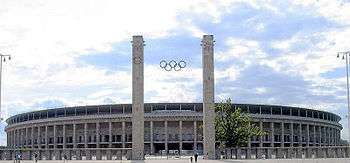Werner March

| Olympic medal record | ||
|---|---|---|
| Art competitions | ||
| | 1936 Berlin | Town planning |
| | 1936 Berlin | Architecture |
Werner Julius March (17 January 1894 – 11 January 1976) was a German architect, son of Otto March (1845-1913), and brother of Walter March, both also well-known German architects. Otto March designed Germany's 1916 Olympic stadium.
Werner March was born in Charlottenburg and died in Berlin.
For the 1936 Summer Olympics in Germany, March created his most famous work, Berlin Olympic Stadium, which was on the site of the 1916 stadium designed by his father, Otto March. It is unclear whether March was influenced to use a more conservative design to suit Nazi tastes (claimed by Albert Speer), or whether March devised a grand, sweeping architecture that anticipated the spirit of the Third Reich.[1]
The stadium, which has a capacity of 74,228, is one of the Germany's major sports venues and was used both for the 1974 and 2006 FIFA World Cup.
He also created plans for the Central Stadium (Leipzig, GDR), before the Berlin Wall. He designed Carinhall, Hermann Göring's hunting lodge-style country residence near Berlin.
Together with his brother Walter, Werner March won a gold medal in the Art competitions at the Summer Olympics in 1936.[2]
See also
References
- ↑ Ladd, Brian (1997), The Ghosts of Berlin: Confronting German History in the Urban Landscape, University of Chicago Press, pp. 142–143, ISBN 0-226-46762-7
- ↑ http://www.databaseolympics.com/games/gamessport.htm?g=11&sp=ART